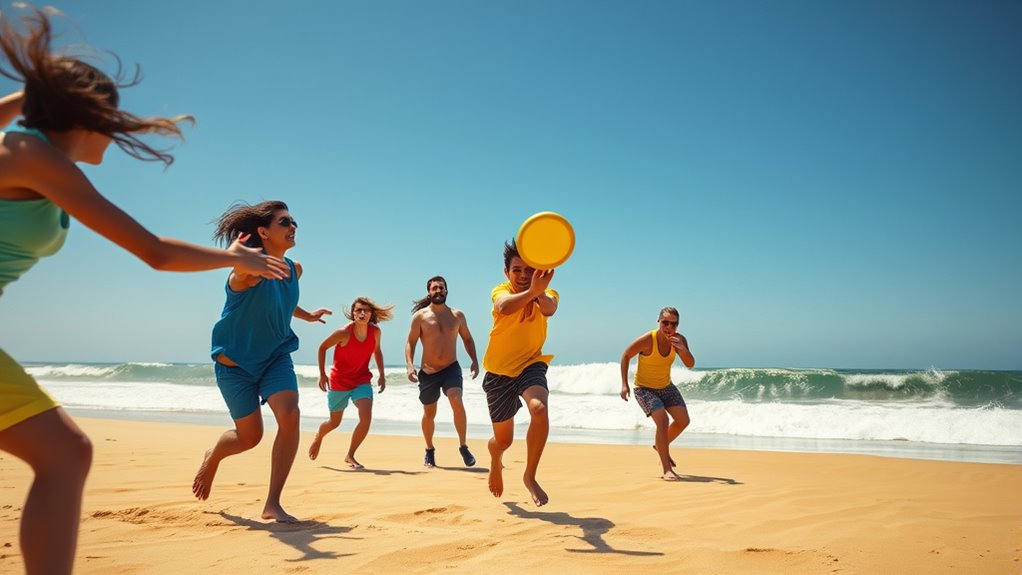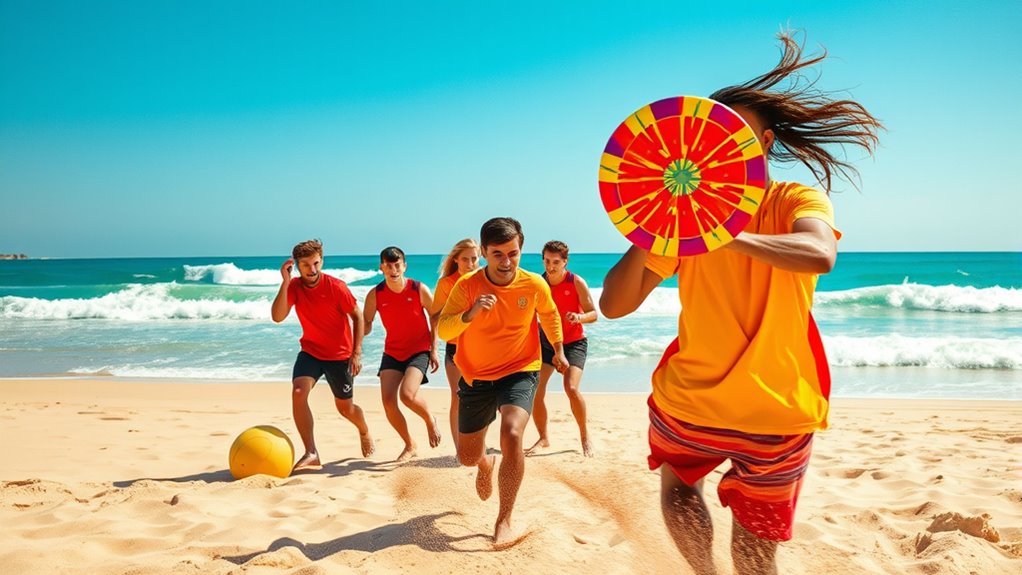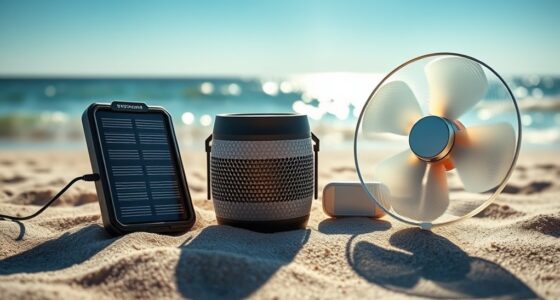To adapt to wind when playing ultimate frisbee on the beach, pay close attention to how wind pushes your disc. Choose heavier, stable discs and adjust your throw angle and power accordingly. Keep your throws low and controlled, and use quick, precise movements to counter gusts. Recognize wind patterns and communicate with teammates to stay ahead. Mastering these strategies will boost your confidence and control—keep going to discover more tips for windy beach games.
Key Takeaways
- Adjust release angles and power to counteract wind direction and strength for better control and accuracy.
- Choose heavier, stable discs with thicker rims to resist wind drift and maintain flight stability.
- Use low, controlled throws and focus on accuracy over distance to minimize wind interference.
- Communicate with teammates about wind conditions to coordinate strategic positioning and throws.
- Practice wind-specific techniques like adjusting grip, body lean, and follow-through to enhance resilience against gusts.
Understanding How Wind Affects Your Throws

Wind can considerably impact your throws, especially on the beach where conditions are often unpredictable. When the wind blows, it can push your disc off course, making accurate throws more challenging. A tailwind can carry your disc farther, but it might also cause it to fly higher and wobble, reducing control. Headwinds tend to slow the disc down and cause it to drop sooner, forcing you to throw with more force or alter your angle. Crosswinds are particularly tricky, pushing your disc sideways and making it hard to aim precisely. Recognizing how wind interacts with your throws helps you adapt your technique, like adjusting your release angle or power. Adjusting your throwing technique in response to wind conditions is crucial for maintaining accuracy. Being aware of wind effects can help you anticipate and compensate for unpredictable conditions, improving your overall game. Understanding aerodynamics is essential for improving your control and consistency, even when the beach conditions are less than perfect. Developing a solid understanding of disc flight characteristics can further enhance your ability to adapt to changing wind conditions. Recognizing these effects will improve your accuracy and consistency, even when the beach conditions are less than perfect. Proper technique is essential for maintaining control and precision in windy conditions.
Choosing the Right Disc for Windy Conditions

When the weather turns windy on the beach, selecting the right disc becomes essential for maintaining control and accuracy. Opt for a disc with a heavier weight, as it’s less affected by gusts and stays steadier in the air. Choose a disc with a more stable or understable flight path; these tend to resist wind drift better than more overstable discs. Avoid lightweight or highly overstable discs, which can be easily blown off course. Look for discs with a thicker rim, providing more grip and control during throws. Pairing the right disc with a firm grip and a controlled release helps you combat the wind’s influence. Additionally, understanding Hackathons and their virtual or in-person formats can inspire innovative strategies for adapting to challenging conditions like wind. Recognizing the importance of environmental conditions can further refine your disc selection and throwing technique, ensuring better performance despite gusts. Paying attention to market volatility and trends can also help you anticipate how environmental factors might affect your game. Incorporating weather adaptability into your overall game strategy can give you an edge in unpredictable beach wind conditions. Being aware of the aerodynamics of your disc and how it responds to wind can also improve your consistency and control during throws. Remember, the goal is to find a disc that offers predictability and stability despite gusts, increasing your chances of successful throws on a breezy beach day.
Adjusting Your Throwing Technique to Combat Wind

To effectively combat windy conditions on the beach, you need to adjust your throwing technique to maintain control and accuracy. Focus on a lower, more stable arm motion to reduce the disc’s susceptibility to gusts. Use a firmer grip to prevent wobbling, and throw with a slightly flatter angle to minimize lift. Additionally, adopt a shorter, more controlled release to keep the disc on its intended path. Here’s a helpful guide:
| Technique Adjustment | Benefit | Tip |
|---|---|---|
| Lower arm angle | Reduces lift from wind | Keep your elbow close to your side |
| Firmer grip | Prevents wobbling | Squeeze gently but firmly |
| Shorter, controlled release | Improves accuracy | Focus on a quick, smooth release |
| Flat disc angle | Minimizes wind effect | Aim to keep the disc level |
| Consistent follow-through | Maintains direction | Follow through toward your target |
Engaging in proper technique can further enhance your performance in windy conditions. Additionally, understanding wind dynamics can help you better anticipate how gusts will influence your throws, especially when considering the rugged beach terrain, which can impact disc flight. Improving your throwing mechanics is essential for adapting to challenging outdoor environments.
Developing Strategies for Windy Beach Games

Playing ultimate frisbee on a windy beach requires you to adapt your game plan to the conditions. Focus on tighter, more controlled throws to minimize wind interference. Shorten your passes and aim for accuracy rather than distance, which helps prevent turnovers. Communicate clearly with your teammates about the wind’s direction so everyone can adjust their positioning and throws accordingly. Use the wind to your advantage by throwing low and into the wind, making it harder for opponents to catch or intercept. Be prepared to change your strategies quickly if the wind shifts suddenly. Incorporate quick pivots and dynamic movement to stay unpredictable. Additionally, studying how wind affects ball flight can give you a strategic edge in adjusting your throws effectively. Paying attention to wind patterns and how they influence the ball can help you better anticipate its trajectory. Understanding the effects of wind on frisbee can also enhance your ability to adapt your throws in real-time, giving you an advantage during the game. Recognizing team communication as a crucial element will ensure everyone remains coordinated despite changing conditions. Being aware of local weather forecasts can help you plan your strategies before the game begins. By adjusting your tactics, you’ll maintain control and keep the game competitive despite challenging wind conditions.
Practicing Wind-Resilient Skills for Better Performance

Practicing wind-resilient skills is key to performing well on a windy beach. Focus on controlling your throws by adjusting your grip and release point to counteract gusts. Work on low, stable passes that stay close to the ground, reducing the chance of the disc being caught by the wind. Improve your body positioning—lean into the wind and use your core to stabilize throws. Practice quick, confident catches with soft hands to handle unpredictable gusts. Drill your footwork to maintain balance when wind shifts suddenly. Proper technique is essential for adapting to changing wind conditions and maintaining accuracy during play. By dedicating time to these skills, you’ll become more adaptable and confident in windy conditions. Over time, you’ll develop an instinct for how the wind affects your throws and catches, making you a stronger player on challenging beach days. Consistent practice can also help in understanding how Glycolic Acid benefits influence skin resilience, much like developing wind resilience improves overall performance. Incorporating bicycle gear shifting techniques strategies can help optimize your movements and stability during play, especially when adjusting to environmental variables. Additionally, embracing a growth mindset allows players to view challenges like wind as opportunities for improvement rather than setbacks.
Frequently Asked Questions
How Does Humidity Impact Disc Flight in Windy Beach Conditions?
Humidity affects disc flight by making the air denser, which can slow the disc down and reduce its glide. In windy beach conditions, higher humidity can cause your throws to drop more quickly or veer off course. You might need to adjust your power and angle, throwing with a little less force and more spin to counteract these effects. Practice and observation will help you fine-tune your throws in humid, windy environments.
Can Specific Footwear Improve Stability During Windy Beach Frisbee Games?
Footwear can definitely boost your stability during windy beach frisbee games. Look for shoes with solid, slip-resistant soles that grip the gritty, uneven terrain. Lightweight, flexible footwear helps you move with more finesse and fend off falls caused by gusts. By choosing shoes designed for traction and support, you’ll confidently confront the chaos of wind, making catches and throws smoother, safer, and more secure amid the sandy, gusty conditions.
What Are the Best Times of Day for Less Windy Beach Play?
You should play during early mornings or late evenings when the wind tends to be calmer. Midday often brings the strongest breezes, making the game more challenging and less enjoyable. Checking local weather forecasts can help you pick ideal times. By choosing these quieter periods, you’ll find better control over your throws and a more enjoyable experience overall, especially if you’re trying to avoid the wind’s impact on your game.
How Do Different Beach Terrains Affect Wind Behavior and Disc Flight?
Think of beach terrains as the ocean’s whispers shaping your journey. Soft sand absorbs wind, giving your disc a smoother flight, like gentle waves guiding a boat. Rocky areas create turbulence, making your throws unpredictable, like a stormy sea. Recognize how dunes or flat stretches influence wind flow, helping you adapt your throws. By understanding terrain effects, you become a seasoned sailor steering through unpredictable winds with confidence.
Are There Safety Considerations Unique to Playing Frisbee in Strong Wind on the Beach?
Playing frisbee in strong wind requires you to stay alert to safety risks. You should avoid aiming at others, as gusts can cause unpredictable disc movements. Keep a safe distance from obstacles like rocks or cliffs to prevent injury if the disc blows off course. Also, be mindful of your surroundings, including other players and spectators, to avoid accidental hits. Always communicate clearly, and stop playing if conditions become too dangerous.
Conclusion
So, next time the wind’s throwing your throws off, just remember: it’s not you, it’s the weather conspiring against your frisbee mastery. Embrace the chaos, pick the right disc, and tweak your technique—after all, everyone loves a good beach breeze to spice up their game. With a little practice and a dash of wind-resilience, you’ll be the beach’s ultimate frisbee hero—until the next gust ruins everything, of course. Keep tossing, and let the wind be your unwitting coach!










